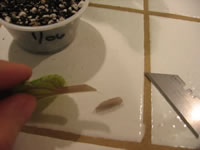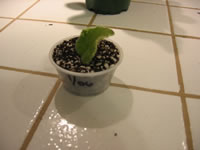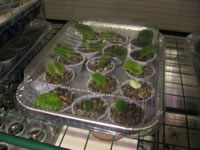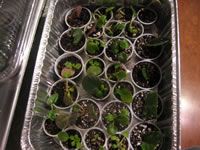How to Propagate New Plants with Whole Leaf CuttingsSome, but not all, plants can be propagated from just a leaf or a section of a leaf. The majority of the plants that are usable for leaf cutting propagation are considered to be house plants. African Violets, some Begonias, Crassulas, Gloxinias, Peperomias, Sanseverias and Sedums are some of the plants that can be propagated with leaf cuttings. When selecting a leaf to use for propagation, always choose one that is firm and healthy. |
||||
| ||||
Whole Leaf CuttingsSome broad-leaved plants have the ability to create new roots on a single leaf.With many larger leaved species, like Rex Begonias, a single leaf can be used to create multiple clones by using the wedge cutting or split vein methods of propagation. Moisten the medium before inserting cuttings, and keep it evenly moist during the entire propagation process. Using a nail or small stick, make evenly spaced (if you are using a tray...), slightly angled cutting holes to a depth equal to the length of the petiole (the leaf stem). Select an appropriate, healthy leaf and remove it (with stem) from the plant. Using a sharp, sterile knife, sever the leaf petiole from the plant as close to the crown as possible. Immediately before striking your cutting, re-cut the stem 1"-1½" from the leaf, at an slight (45°) angle. Try to match the angle of your cut to the angle of the leaf. Dip the cut end of the stem into a good rooting hormone before inserting it into your rooting media, deep enough that about ¼" of the base of the leaf and the mid vein is buried in the rooting medium. Gently press the soil around the cutting. Place the tray in a warm (70°-75°), brightly lit area or preferably, under a grow light for 14 hours a day. Because they have no roots, your cuttings will need very high humidity, and will really benefit if they are kept in a propagating case, terrarium, or in a mini greenhouse.
The cuttings should begin to produce roots in about two weeks. You should have a new plantlet in about eight weeks! | ||||
|
||||
Search The Garden Helper:




